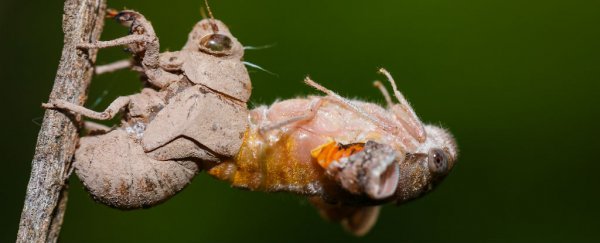Perhaps it's global warming or climate confusion. Maybe it's just really hard for a 17-year cicada to count down the years while he's buried underground.
Why this is happening is a total question mark, but a small fraction of the 17-year cicadas - the ones we're supposed to see in 2021 - are creeping out of their zombie caskets this week, four years early.
The bug experts at cicadamania.com (which, if you're interested, has more information about these giant bugs than you'll be able to consume in one sitting) confirmed our surprise visitors are Brood X precursors and not the Brood VI cicadas that are emerging in other parts of the country this year.
Apparently the DC area cicadas just lost track of time.
Periodical cicadas are warm-weather insects. They emerge only after the ground temperature reaches the mid-60s about eight inches below the surface. Cicadas don't get fooled into emerging during January thaws or during early spring warm spells.
 Kevin Ambrose
Kevin Ambrose
It's all about the ground temperature. They typically emerge during the month of May in DC and the surrounding region, but it's possible they can emerge during late April if we have an extremely warm spring.
Cicadas are slow, clumsy bugs that are easily caught. They will fly directly into a predator - and they will also fly directly into the faces of people who are completely freaked out by giant, ugly locusts getting tangled in their hair.
We have many area residents who are emotionally scarred by past cicada encounters.
For the periodical cicadas to survive and reproduce, they must emerge in massive numbers, from tens of thousands to a million bugs per acre. There are many predators of the slow-flying bug, including birds, squirrels, dogs, cats and people who say cicadas taste like shrimp.
They overwhelm their predators by sheer number - the only reason they survive is there are too many bugs to eat.
So far, the current batch of early-arriving cicadas are sparse in numbers and are quickly falling victim to feasting birds.
The next week or two will be telling if they continue to emerge in larger numbers and begin to mate, or fade to a brief, buzzing memory with some well-fed birds flying around. For those of you who fear cicadas, don't worry yet.
If a sufficiently large number of cicadas do emerge this year and successfully mate, a new brood of cicadas may establish itself for a return visit in 2034. That doesn't seem likely at this point.
Look out for May 2021, however, that will be the time when the vast majority of Brood X arrives.
2017 © The Washington Post
This article was originally published by The Washington Post.
